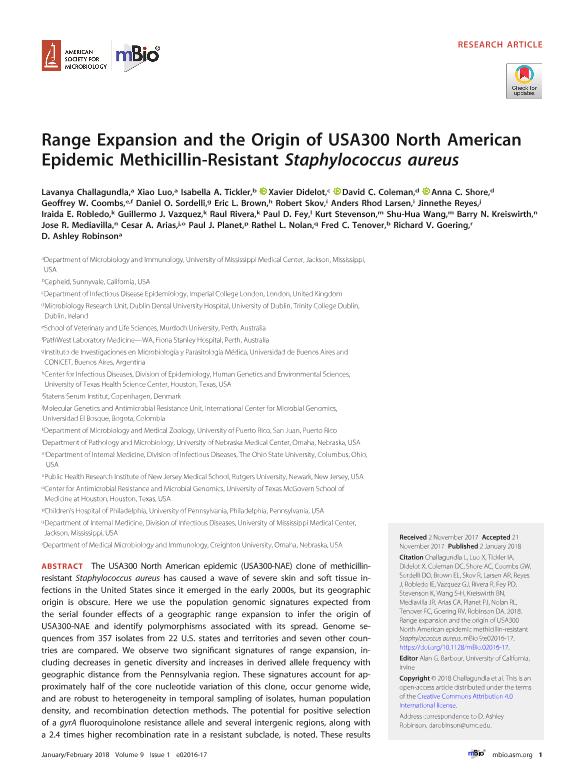Mostrar el registro sencillo del ítem
dc.contributor.author
Challagundla, Lavanya
dc.contributor.author
Luo, Xiao
dc.contributor.author
Tickler, Isabella A.
dc.contributor.author
Didelot, Xavier
dc.contributor.author
Coleman, David C.
dc.contributor.author
Shore, Anna C.
dc.contributor.author
Coombs, Geoffrey W.
dc.contributor.author
Sordelli, Daniel Oscar

dc.contributor.author
Brown, Eric L.
dc.contributor.author
Skov, Robert
dc.contributor.author
Larsen, Anders Rhod
dc.contributor.author
Reyes, Jinnethe
dc.contributor.author
Robledo, Iraida E.
dc.contributor.author
Vazquez, Guillermo Javier

dc.contributor.author
Rivera, Raul
dc.contributor.author
Fey, Paul D.
dc.contributor.author
Stevenson, Kurt
dc.contributor.author
Wang, Shu-Hua
dc.contributor.author
Kreiswirth, Barry N.
dc.contributor.author
Mediavilla, Jose R.
dc.contributor.author
Arias, Cesar A.
dc.contributor.author
Planet, Paul J.
dc.contributor.author
Nolan, Rathel L.
dc.contributor.author
Tenover, Fred C.
dc.contributor.author
Goering, Richard V.
dc.contributor.author
Robinson, D. Ashley
dc.date.available
2019-11-25T20:09:47Z
dc.date.issued
2018-01
dc.identifier.citation
Challagundla, Lavanya; Luo, Xiao; Tickler, Isabella A.; Didelot, Xavier; Coleman, David C.; et al.; Range expansion and the origin of USA300 north american epidemic methicillin-resistant Staphylococcus aureus; American Society for Microbiology; mBio; 9; 1; 1-2018; 1-15; e02016-17
dc.identifier.uri
http://hdl.handle.net/11336/89728
dc.description.abstract
The USA300 North American epidemic (USA300-NAE) clone of methicillin-resistant Staphylococcus aureus has caused a wave of severe skin and soft tissue infections in the United States since it emerged in the early 2000s, but its geographic origin is obscure. Here we use the population genomic signatures expected from the serial founder effects of a geographic range expansion to infer the origin of USA300-NAE and identify polymorphisms associated with its spread. Genome sequences from 357 isolates from 22 U.S. states and territories and seven other countries are compared. We observe two significant signatures of range expansion, including decreases in genetic diversity and increases in derived allele frequency with geographic distance from the Pennsylvania region. These signatures account for approximately half of the core nucleotide variation of this clone, occur genome wide, and are robust to heterogeneity in temporal sampling of isolates, human population density, and recombination detection methods. The potential for positive selection of a gyrA fluoroquinolone resistance allele and several intergenic regions, along with a 2.4 times higher recombination rate in a resistant subclade, is noted. These results are the first to show a pattern of genetic variation that is consistent with a range expansion of an epidemic bacterial clone, and they highlight a rarely considered but potentially common mechanism by which genetic drift may profoundly influence bacterial genetic variation. IMPORTANCE The process of geographic spread of an origin population by a series of smaller populations can result in distinctive patterns of genetic variation. We detect these patterns for the first time with an epidemic bacterial clone and use them to uncover the clone’s geographic origin and variants associated with its spread. We study the USA300 clone of methicillin-resistant Staphylococcus aureus, which was first noticed in the early 2000s and subsequently became the leading cause of skin and soft tissue infections in the United States. The eastern United States is the most likely origin of epidemic USA300. Relatively few variants, which include an antibiotic resistance mutation, have persisted during this clone’s spread. Our study suggests that an early chapter in the genetic history of this epidemic bacterial clone was greatly influenced by random subsampling of isolates during the clone’s geographic spread.
dc.format
application/pdf
dc.language.iso
eng
dc.publisher
American Society for Microbiology

dc.rights
info:eu-repo/semantics/openAccess
dc.rights.uri
https://creativecommons.org/licenses/by-nc-sa/2.5/ar/
dc.subject
EPIDEMICS
dc.subject
FLUOROQUINOLONES
dc.subject
FOUNDER EFFECTS
dc.subject
GENETIC DRIFT
dc.subject
POPULATION GENETICS
dc.subject
RANGE EXPANSION
dc.subject.classification
Otras Medicina Básica

dc.subject.classification
Medicina Básica

dc.subject.classification
CIENCIAS MÉDICAS Y DE LA SALUD

dc.title
Range expansion and the origin of USA300 north american epidemic methicillin-resistant Staphylococcus aureus
dc.type
info:eu-repo/semantics/article
dc.type
info:ar-repo/semantics/artículo
dc.type
info:eu-repo/semantics/publishedVersion
dc.date.updated
2019-10-10T14:59:27Z
dc.identifier.eissn
2150-7511
dc.journal.volume
9
dc.journal.number
1
dc.journal.pagination
1-15; e02016-17
dc.journal.pais
Estados Unidos

dc.journal.ciudad
Washington DC
dc.description.fil
Fil: Challagundla, Lavanya. University of Mississippi; Estados Unidos
dc.description.fil
Fil: Luo, Xiao. University of Mississippi; Estados Unidos
dc.description.fil
Fil: Tickler, Isabella A.. Cepheid; Estados Unidos
dc.description.fil
Fil: Didelot, Xavier. Imperial College London; Reino Unido
dc.description.fil
Fil: Coleman, David C.. Universidad de Dublin; Irlanda
dc.description.fil
Fil: Shore, Anna C.. Universidad de Dublin; Irlanda
dc.description.fil
Fil: Coombs, Geoffrey W.. PathWest Laboratory Medicine, Fiona Stanley Hospital; Australia
dc.description.fil
Fil: Sordelli, Daniel Oscar. Consejo Nacional de Investigaciones Científicas y Técnicas. Oficina de Coordinación Administrativa Houssay. Instituto de Investigaciones en Microbiología y Parasitología Médica. Universidad de Buenos Aires. Facultad de Medicina. Instituto de Investigaciones en Microbiología y Parasitología Médica; Argentina
dc.description.fil
Fil: Brown, Eric L.. University of Texas; Estados Unidos
dc.description.fil
Fil: Skov, Robert. Statens Serum Institut; Dinamarca
dc.description.fil
Fil: Larsen, Anders Rhod. Statens Serum Institut; Dinamarca
dc.description.fil
Fil: Reyes, Jinnethe. Universidad El Bosque; Colombia
dc.description.fil
Fil: Robledo, Iraida E.. Universidad de Puerto Rico; Puerto Rico
dc.description.fil
Fil: Vazquez, Guillermo Javier. Universidad de Puerto Rico; Puerto Rico
dc.description.fil
Fil: Rivera, Raul. Universidad de Puerto Rico; Puerto Rico
dc.description.fil
Fil: Fey, Paul D.. University of Nebraska; Estados Unidos
dc.description.fil
Fil: Stevenson, Kurt. Ohio State University; Estados Unidos
dc.description.fil
Fil: Wang, Shu-Hua. Ohio State University; Estados Unidos
dc.description.fil
Fil: Kreiswirth, Barry N.. Rutgers University. New Jersey Medical School; Estados Unidos
dc.description.fil
Fil: Mediavilla, Jose R.. Rutgers University. New Jersey Medical School; Estados Unidos
dc.description.fil
Fil: Arias, Cesar A.. University of Texas; Estados Unidos
dc.description.fil
Fil: Planet, Paul J.. University of Pennsylvania; Estados Unidos
dc.description.fil
Fil: Nolan, Rathel L.. University of Mississippi; Estados Unidos
dc.description.fil
Fil: Tenover, Fred C.. Cepheid; Estados Unidos
dc.description.fil
Fil: Goering, Richard V.. Creighton University; Estados Unidos
dc.description.fil
Fil: Robinson, D. Ashley. University of Mississippi; Estados Unidos
dc.journal.title
mBio
dc.relation.alternativeid
info:eu-repo/semantics/altIdentifier/url/https://mbio.asm.org/content/9/1/e02016-17
dc.relation.alternativeid
info:eu-repo/semantics/altIdentifier/doi/http://dx.doi.org/10.1128/mBio.02016-17
Archivos asociados
